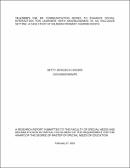| dc.contributor.author | Jepkoech Chesire, Betty | |
| dc.date.accessioned | 2022-02-27T09:53:25Z | |
| dc.date.available | 2022-02-27T09:53:25Z | |
| dc.date.issued | 2022-02 | |
| dc.identifier.citation | Jepkoech Chesire, Cetty (2022) Teacher’s use of communication modes to enhance social interaction for learners with deaf blindness in an inclusive setting: a case study at Kilimani primary, Nairobi Kenya | en_US |
| dc.identifier.uri | https://kyuspace.kyu.ac.ug/xmlui/handle/20.500.12504/715 | |
| dc.description | x,60 p.: ill (somecol) | en_US |
| dc.description.abstract | The purpose of the study was to investigate teacher’s use of communication modes to enhance social interaction for learners with deaf blindness in an inclusive setting. The study was guided by the following objectives; to find out modes of communication and social interaction in an inclusive classroom, to determine the challenges learners with deaf blindness (LWDB) encounter during interaction with the typical peers in an inclusive classroom and to find out the innovative strategies the teachers apply to improve communication and social interaction on(LWDB) in an inclusive classrooms. The researcher hoped that the study was able to benefit all the stakeholders concerned to support the (LWDB), to fit in the inclusive setting. The study focused Kilimani primary school in Nairobi, Kenya as a case study, where inclusion of children with deafblindness takes place in Kenya; The research design used in the study was qualitative approach. The researcher chose to use semi structured interviews and observation methods. The research paradigm used was constructivism. The study was a case study therefore the population was of a small number. The total Number of participants were nine (9); being seven (7) teachers who were specialized in the area of deafblindness and two (2) (LWDB), who were the only (LWDB) in the inclusive setting in public primary schools in the whole of Kenya. The sampling technique used was purposive sampling technique. The methods of data collection were two; (i) interviewing trained teachers in the area of deaf blindness using prepared teachers interview guides and interviewing (LWDB) using interview learners’ guides, (ii) Using an observation guide for the same (LWDB). During the data analysis, the researcher employed a thematic analysis system where the objectives that guided the study were used. She presented findings and interpretations using bar graphs where possible and then discussions. Later, she summarized, concluded and gave her recommendations of the study on mode of communication and social interaction on (LWDB) in an inclusive setting. | en_US |
| dc.language.iso | en | en_US |
| dc.publisher | Kyambogo University (un published work) | en_US |
| dc.subject | Communication modes. | en_US |
| dc.subject | Social interaction. | en_US |
| dc.subject | Learners. | en_US |
| dc.subject | Deaf blindness. | en_US |
| dc.title | Teacher’s use of communication modes to enhance social interaction for learners with deaf blindness in an inclusive setting: a case study at Kilimani primary, Nairobi Kenya | en_US |
| dc.type | Thesis | en_US |

